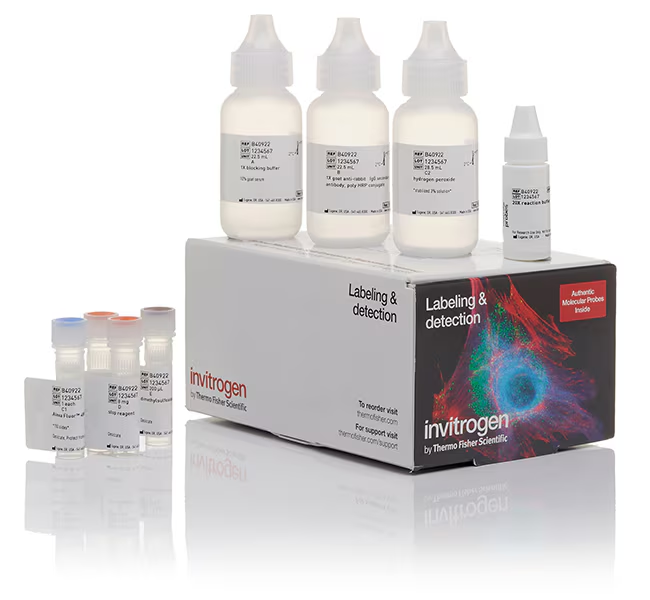
SuperBoost™ tyramide signal amplification is the most sensitive method for detection of low abundant targets in multiplexable fluorescent immunocytochemistry (ICC), immunohistochemistry (IHC ), and in situ hybridization (ISH). SuperBoost kits combine the brightness of AlexaFluor™ dyes with the superior signal amplification of a poly-HRP-mediated tyramide labeling reaction to produce a sensitivity 10-200 times greater than standard methods. SuperBoost kit sensitivity is also 2-10 times greater than regular tyramide amplification techniques like TSA™. For standout research, SuperBoost kits sharpen your results for clear visibility into critical areas that standard imaging methods fail to reveal.
SuperBoost kits are simple to use and easily adapted to standard ICC, IHC, or FISH experimental protocols, using any cell or tissue type. Cells labeled using a SuperBoost kit can be imaged using any type of microscope, producing high-resolution multiplex images. This particular kit features AlexaFluor 488 tyramide (496/524 ex/em), detected using a standard Green/FITC/GFP filter cube. This kit also features poly-HRP-conjugated goat anti-rabbit IgG secondary antibody.
Features of the SuperBoost kits include:
• Superior sensitivity for detection of low-level or hard-to-detect targets by fluorescent imaging
• Simple protocol and detection using standard filters
• Suitable for high-resolution multiplex images—co-label with DAPI, secondary antibodies, and other SuperBoost kits
• Requires 10-100 times less primary antibody then standard ICC/IHC/ISH experiments
SuperBoost kits are based on the tyramide signal amplification system, which uses the catalytic activity of horseradish peroxidase (HRP) to generate high density labeling of a target protein or nucleic acid sequence in situ. A typical ICC/IHC/ISH experiment using a SuperBoost kit requires 10-100 times less primary antibody then standard ICC/IHC/ISH experiments. SuperBoost kits offer superior specific signal intensity over background, so the protocol is easily optimized to detect specific signal in samples where high endogenous autofluorescence is observed.
Benefits of SuperBoost kits
Enhancement of signal using Alexa Fluor tyramides: SuperBoost kits utilize Alexa Fluor tyramides, which react with HRP to ultimately deposit bright and photostable Alexa Fluor dye on surrounding proteins and other similar molecules. SuperBoost kits are the only kits that combine the brightness of Alexa Fluor dyes with the enhancement of tyramide signal amplification to produce a superior signal.
Poly-HRP enhancement: Unlike TSA, SuperBoost kits employ poly-HRP-conjugated secondary antibodies. In such systems, several HRP enzymes are conjugated with short polymers, enhancing the signal by several fold over regular HRP systems. The poly-HRP is structured in such a way that the antibodies penetrate cells or tissue as efficiently as regular HRP-conjugated secondary antibodies. The molar enzyme/antibody protein ratio has an average value of '4'.
Reaction stop solution: Like any enzyme-based labeling system, it is possible to overdevelop the signal. SuperBoost kits include an HRP stop solution to halt the HRP reaction. HRP stop solution can be used to obtain maximum signal, without increase of background signal. Images produced with optimized HRP reaction times are as sharp as images produced with standard ICC/IHC/ISH methods, but with 10-200 times more sensitivity.
Reduction of background: SuperBoost kits include blockers for the elimination or reduction of endogenous peroxidase and fluorescent background signals. These blockers help ensure that only specific signals are enhanced while keeping non-specific/background signals in check.
| Code | Description |
|---|---|
| B40943 | Catalog Number: B40943 |
| B40922 | Catalog Number: B40922 |

